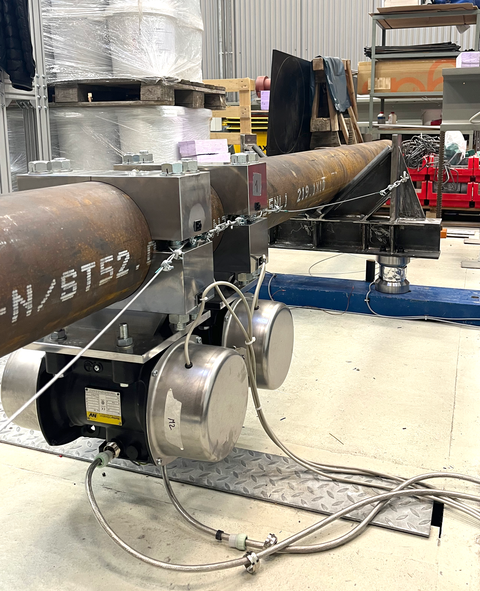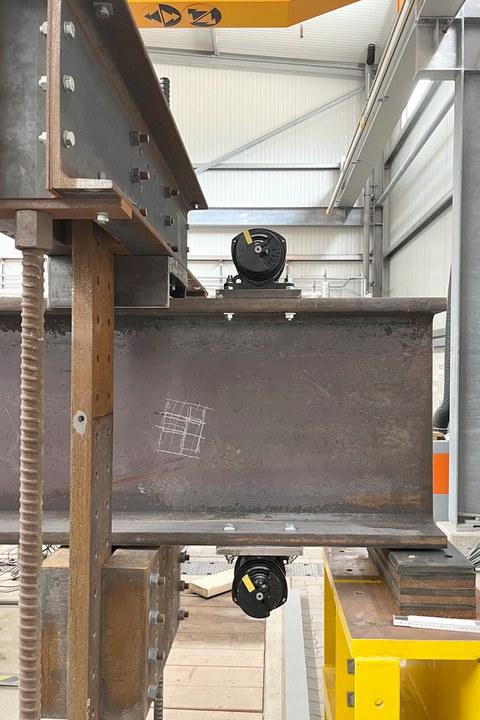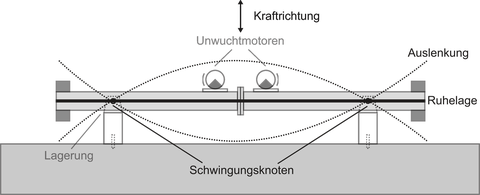Entwicklung und Optimierung resonanzbasierter Prüfmethoden | ResoWind
Inhaltsverzeichnis
Projektdaten
|
Titel | Title |
Abschluss
Turmkonstruktionen von Windenergieanlagen können im Laufe ihres Lebens von 25 Jahren Lastwechselzahlen > 107 erfahren. Für die Tragsicherheitsnachweis sind großmaßstäbliche zyklische Versuche erforderlich. Diese sind jedoch mit herkömmlicher hydraulischer Prüftechnik sehr energie- und zeitintensiv. Durch die Verwendung von elektrischen Unwuchtmotoren als Aktuatoren werden dagegen sehr hohe Belastungsfrequenzen nahe der Eigenfrequenz des Prüfkörpers erreicht. Die resonanzbasierte dynamische Verstärkung der Belastungsgröße ist aus Gründen der Energie- und Zeiteinsparung höchst effizient.
In diesem Projekt wurde das resonanzbasierte Prüfprinzip um zwei Anwendungsfälle erweitert und an zwei Demonstratoren getestet. Der Demonstrator I ermöglichte hochzyklische Versuche an axial beanspruchten Probekörpern unter einer definierten Mittellast. In Druckschwell- und in Zugschwellversuchen konnten Kraftschwingbreiten bis ca. 300 kN bei einer Erregerfrequenz von ca. 14 Hz erreicht werden. Die Ausnutzung der dynamischen Vergrößerung durch den Resonanzeffekt in Kombination mit einer Hebelwirkung führten zur Vergrößerung der Kräfte um das 45-Fache.
Der Demonstrator II wurde für zyklische Versuche an biegebeanspruchten Probekörpern entwickelt. Das Besondere hierbei war seine Schwingungsknotenlagerung, bei der die Auflagerpositionen mit den Schwingungsknoten der anzuregenden Eigenfrequenz übereinstimmte. In den Schwingungsknoten waren die Verschiebungen und folglich auch die Auflagerkräfte null. Bei einer Anregung knapp unterhalb der Eigenfrequenz konnten die Auflagerkräfte in den Versuchen auf ca. 10 % gegenüber der einwirkenden Kraft reduzierten werden, sodass eine Übertragung der Vibrationen in die Umgebung gering war.
Mit diesem Projekt konnte die Anwendungsvielfalt und Effizienz der resonanzbasierten Prüfmethode mit Unwuchtantrieben aufgezeigt und somit die zukünftige Ermüdungsforschung großer Bauteile erleichtert werden.
Bericht aus dem Jahrbuch 2022
Innovative Resonanzversuchsstände

Mittig angeordnete Unwuchtmotoren bei Demonstrator II
Windenergieanlagen unterliegen im Laufe ihrer Lebensdauer von 25 Jahren hohen zyklischen Beanspruchungen. Insbesondere bei Offshoreanlagen, welche zusätzlich zur Wind- auch eine Wellenbeanspruchung erfahren, können Lastwechselzahlen > 107 auftreten. Daher sind experimentelle Untersuchungen des Ermüdungsverhaltens an Tragstrukturelementen von Windenergieanlagen von großer Bedeutung. Die Prüfung mit herkömmlichen servohydraulischen Aktuatoren ist infolge der begrenzten Prüffrequenz sehr kostenintensiv. Aus diesem Grund wurde an der Leibniz Universität Hannover eine Resonanzprüfmethode mit synchronisierten Unwuchtantrieben entwickelt. Mit dieser ist es möglich, mit hohen Belastungsfrequenzen > 15 Hz und gleichzeitig geringem Energieaufwand zu prüfen.
Um die Resonanzprüfmethodik auch für Großbauteilversuche zu erweitern, wurden zwei Demonstratoren entwickelt: Demonstrator I für axial beanspruchte und Demonstrator II für biegebeanspruchte Tragstrukturen. Demonstrator I funktioniert als Kragarmsystem mit gelenkiger Lagerung. Der Probekörper wird entweder unterhalb (Druckprobe) oder oberhalb (Zugprobe) des Kragträgers platziert. Mithilfe von Zugfedern wird eine Mittellast aufgebracht. Am freien Ende erzeugen zwei gegenläufige Motoren eine vertikal gerichtete Schwingung. Demonstrator II ist als Vier-Punkt-Biegeversuch konzipiert und wird ebenfalls mit zwei gegenläufigen Unwuchtmotoren in vertikaler Richtung angeregt. Um eine unerwünschte Schwingungsweiterleitung in die Umgebung zu vermeiden, wird der Probekörper in den Schwingungsknoten seiner Eigenfrequenz gelagert. Bei Anregung knapp unterhalb der Eigenfrequenzen können somit die Auflagerkräfte stark reduziert und eine problematische Schwingungsübertragung vermieden werden.
Testversuche haben gezeigt, dass Ermüdungsversuche unter Druck- und Zugbeanspruchungen mit dem Demonstrator I realisierbar sind. Die Axialkraft im Probekörper konnte während des Versuchs konstant gehalten werden. Der Demonstrator II bestätigte den enormen Einfluss der Auflagerposition im Bereich der Schwingungsknoten auf die Reduzierung der Auflagerkraft.
Bericht aus dem Jahrbuch 2021
Resonanz clever genutzt

Zwei Unwuchtmotoren zur vertikalen Lasterzeugung am Demonstrator II
Experimentelle Untersuchungen großer Bauteile, wie sie bei Windenergieanlagen eingesetzt werden, sind in ihrer Umsetzung mit viel Aufwand verbunden. Insbesondere die Untersuchung des Ermüdungsverhaltens, welches infolge hoher zyklischer Beanspruchungen durch Wind- und Wellenbelastung von großer Bedeutung ist, kann mit herkömmlichen servohydraulischen Aktuatoren sehr ineffizient werden. Die Idee: resonanzbasiertes Prüfen. Hierfür wurde am Institut für Massivbau der Leibniz Universität Hannover bereits ein Resonanzversuchsstand entwickelt bei dem synchronisierte Unwuchtantriebe mit minimalem Energieaufwand und gleichzeitig hoher Erregerfrequenz zyklische Ermüdungsbeanspruchungen erzeugen.
Im Rahmen dieses Projektes heißt es, die Resonanzprüfmethodik weiter zu erforschen und für unterschiedliche Anwendungen praktikabel zu gestalten. Ziel ist es, experimentelle Untersuchungen großer Bauteile bei hohen Frequenzen (20–50 Hz) und hohen Lastwechselzahlen (N > 107) energie- und zeitsparend und somit kostengünstig zu ermöglichen. Hierfür werden zwei Demonstratoren entwickelt: Demonstrator I für axial auf Zug oder Druck beanspruchte Proben und Demonstrator II für biegebeanspruchte Tragstrukturelemente.
Mithilfe von zwei gegenläufige Unwuchtmotoren wird eine vertikale Schwingung erzeugt. Dabei liegt die Erregerfrequenz der Motoren nahe der ersten Biegeeigenfrequenz des gesamten Versuchsstandes, sodass es zu einer Vergrößerung der Kräfte infolge des Resonanzverhaltens kommt. Somit können mit vergleichsweise geringer Erregerkraft große Kräfte erzielt werden. Der Demonstrator I funktioniert als Kragarmsystem mit einer gelenkigen Lagerung. Mithilfe von Zugfedern wird eine Mittellast aufgebracht um die das System schwingt. Die Probekörper werden entweder unterhalb (Druckprobe) oder oberhalb (Zugprobe) des Kragarms platziert. Nach numerischer Betrachtung und Analyse des Versuchsaufbaus, folgt nun die Umsetzung in der Versuchshalle. Das Anspruchsvolle in der Konzipierung des Demonstrators II liegt in seiner Lagerung – einer Schwingungsknotenlagerung. Hierbei gilt es die Schwingungsknoten des Probekörpers (einem Stahlrohr) zu identifizieren, wodurch eine problematische Schwingungsübertragung auf die Umgebung minimiert wird.
Bericht aus dem Jahrbuch 2020
Versuche mit Resonanz

Schematische Darstellung einer Schwingungsknotenlagerung im Resonanzprüfstand
Windenergieanlagen unterliegen im Laufe ihrer Lebensdauer von 20 Jahren hohen zyklischen Beanspruchungen. Insbesondere bei Offshore-Anlagen, welche zusätzlich zur Wind- auch eine Wellenbeanspruchung erfahren, können Lastwechselzahlen > 107 auftreten. Folglich sind Untersuchungen des Ermüdungsverhaltens an Tragstrukturelementen von Offshore-Windenergieanlagen von großer Bedeutung.
Bisher wurden ausschließlich experimentelle Versuche zur Lebensdauer im High- und Very-High-Cycle-Fatigue-Bereich an kleinmaßstäblichen Probekörpern durchgeführt. Aufgrund von Maßstabseffekten liefern jedoch nur großmaßstäbliche experimentelle Untersuchungen die relevanten Messergebnisse, die auf reale Strukturgrößen übertragbar sind. Da im Bereich hoher Lastwechselzahlen Ermüdungsversuche großer Bauteile mit gängigen servohydraulischen Aktuatoren aufgrund des hohen Energiebedarfs und der begrenzten Belastungsfrequenzen nicht mehr effizient durchgeführt werden können, wurde am Institut für Massivbau an der Leibniz Universität in Hannover ein Resonanzversuchsstand entwickelt. Die mit synchronisierten Unwuchtantrieben realisierte Prüfmethode ermöglicht, mit minimalem Energieaufwand und gleichzeitig hoher Erregerfrequenz zyklische Ermüdungsbeanspruchungen zu erzeugen. Allerdings sind die sich auf die Versuchshalle übertragenden Schwingungen derzeit noch limitierende Faktoren, welche die Versuchsdurchführung an größeren Bauteilen, wie sie im Windenergiebereich Anwendung finden, einzuschränken.
Im Rahmen des Verbundvorhabens ResoWind, welches zusammen mit dem Fraunhofer-Institut für Windenergiesysteme (IWES) und dem Testzentrum Tragstrukturen Hannover (TTH) bearbeitet wird, werden die bewährte Resonanzprüfmethode optimiert und somit großmaßstäbliche Versuche an Strukturen durchführbar. Für ermüdungsbeanspruchte Tragstrukturen von Offshore-Windenergieanlagen werden Demonstratoren konzipiert, die Untersuchungen sowohl an axial auf Zug und Druck beanspruchte als auch an biegebeanspruchte Tragstrukturelementen ermöglichen. Bei der Konzipierung des Demonstrators für Biegebeanspruchungen liegt der Schwerpunkt in der Entwicklung einer Schwingungsknotenlagerung, wodurch die problematische Schwingungsübertragung auf die Umgebung minimiert wird. Mit den Demonstratoren für axiale Druck- und Zugbeanspruchungen wird der Vorteil des geringen Energiebedarfs gegenüber konventioneller hydraulischer Prüftechnik mit der Möglichkeit kombiniert, nahezu beliebige Prüfkörpergeometrien zu verwenden.
